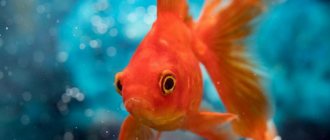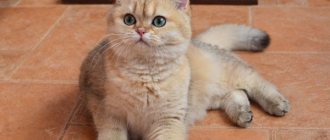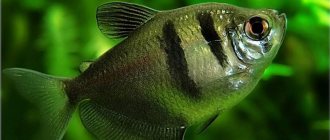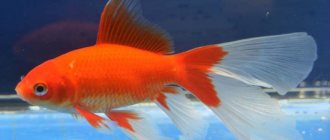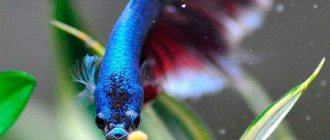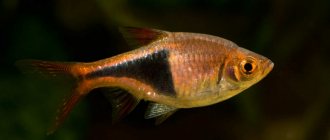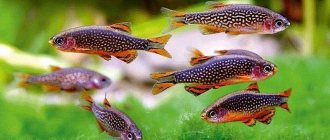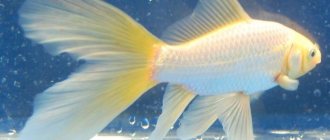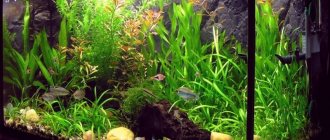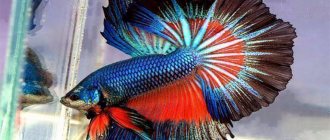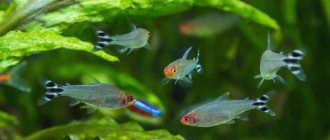The Oranda fish from the Carp family, a variety of Veiltail, is beloved by aquarists for its unusual appearance and beautiful bright colors. The predecessor of the breeding series is Golden Crucian. This variety was bred in Japan in the 15th century, although China is considered its homeland. In Japanese, the name Oranda sounds like "shishiga-shira". The ability to breed specimens of original colors makes it popular among aquarists in all countries, including Russia.
- 1 Description and selection features
- 2 Mr. Tail Recommends: Oranda Varieties
- 3 Basics of aquarium keeping
- 4 Compatibility
- 5 Feeding
- 6 Breeding
- 7 Diseases and prevention
General information and habitat in nature
Oranda is a short-bodied goldfish bred by Chinese aquarium breeders in the 15th century. It is one of the types of veil tail and is represented by several variations, which differ slightly in external characteristics - the location and size of the growths.
The red cap belongs to the decorative aquarium fish from the Carp family. This breed is highly valued in the East, here they are called “Water Flowers”. Based on the oranda, breeders have developed dozens of original hybrids, including by crossing with other goldfish.
All goldfish, and oranda is no exception, are created artificially. Through long and careful selection. They don't exist in nature.
Tosakin - goldfish
Tosakin goldfish photo
The main value of Tosakin Goldfish is its large fan-shaped tail fin, which reaches its greatest extent in the horizontal plane, so all the beauty of the fish is manifested when viewed from above, and not from the side. Body color varies from red to silver in various combinations, and there is also a variety with a dark metallic tint.
Tosakin goldfish photo
Tosakin goldfish photo
The structure of the tail, coupled with the short, heavy body, does not contribute to the gracefulness of movements, which is why Tosakin swims very clumsily. Similar features determined the requirements for the arrangement of the aquarium; it should be shallow with standing water; any internal current, even weak, is unacceptable. Otherwise, it is unpretentious and differs little in maintenance from its relatives, such as Ryukin, Ranchu, Lionhead, etc.
Tosakin goldfish photo
There is no reliable information about the origin of this breeding variety of goldfish, there are several versions, one more beautiful than the other, but if we speak in summary, this is the story - Tosakin was first bred in medieval Japan and until the mid-twentieth century did not leave the borders of its native province, now it is Kochi Prefecture. Large-scale destruction of the prefecture's cities in 1945 during the American bombing and a major earthquake in 1946 almost completely destroyed the Tosakins. One collector named Hiroe Tamura managed to find six surviving fish in a restaurant in Kochi and exchange them for a bottle of potato vodka.
Thus, all modern representatives of this species are direct descendants of these last six surviving fish.
We recommend using Prodibio Aqua'Gold and Gold'Activ - a conditioner and biological culture developed specifically for cold-water fish. Why in ampoules, we wrote about this in more detail here, take a look.
Useful video about goldfish
Editorial: Vallisneria tiger
Featured Video
Subscribe to our YouTube channel so you don't miss anything
Description of appearance
The main feature of the fish is its warty fat formations. Orandas do not have a specific color - a variety of variations are possible. There are fish with a predominance of red, black, blue, as well as their various combinations.
An interesting combination of a completely white body with a red-orange “pompom” located on the head. For some, the fatty growth resembles a flower, for others it resembles tangerine slices - each viewer has their own associations.
Other features of the appearance of the red riding hood:
- The body is shortened. The shape resembles an ellipse.
- On average, the length of the fish reaches 15-20 cm. Some specimens grow up to 25 cm.
- The body has an unpaired dorsal fin. And the long tail limb makes up about 70% of the body. All fins are elongated and transparent.
- The tail fins are forked. And they have rounded blades.
Thanks to its bright and contrasting color, the fish with a red growth has become the most popular variety of oranda.
Price
The cost depends on their age and size. The value increases depending on the size of the red wen on the head and the length of the caudal fin.
| Size, cm | Cost, rubles |
| Fry, 1–2 | 100 |
| Grown-up fry, 2–5 | 200 |
| Teens, 6–8 | 250 |
| Adults, 9–15 | 350 |
| Large representatives, 15–20 | 400–500 |
How are males different from females?
Sexual differences in red caps are weakly expressed, so it is difficult to determine the sex of the fish. But there are, at least presumably, some signs that help establish gender, and you need to focus on them when selecting couples.
Gender differences:
- females are slightly larger and more massive than males;
- The body of males is more elongated;
- Before spawning, males become brighter and have white speckles on their heads.
History of appearance
The exact date of hatching of neither goldfish nor red cap has been established. It is only known that their selection was carried out for a long time in China. The history of breeding aquarium fish dates back centuries and continues to this day.
The ancestor of the oranda is the silver carp. It is also known that its ancestor was the veiltail fish. And it was bred on the basis of the Riukin breed - this is a humpbacked goldfish bred in Japan.
When breeding oranda, selection was carried out according to several external characteristics:
- shortened body;
- growth on the head;
- size and color.
For selection, fish with the largest growths on the head were selected. The larger the “cap”, the more valuable the fish. The cost of the red riding hood and other orandas also depends on the size of the pompom.
Tosakin - goldfish
Tosakin goldfish photo
The main value of Tosakin Goldfish is its large fan-shaped tail fin, which reaches its greatest extent in the horizontal plane, so all the beauty of the fish is manifested when viewed from above, and not from the side. Body color varies from red to silver in various combinations, and there is also a variety with a dark metallic tint.
Tosakin goldfish photo
Tosakin goldfish photo
The structure of the tail, coupled with the short, heavy body, does not contribute to the gracefulness of movements, which is why Tosakin swims very clumsily. Similar features determined the requirements for the arrangement of the aquarium; it should be shallow with standing water; any internal current, even weak, is unacceptable. Otherwise, it is unpretentious and differs little in maintenance from its relatives, such as Ryukin, Ranchu, Lionhead, etc.
Tosakin goldfish photoThere is no reliable information about the origin of this breeding variety of goldfish, there are several versions, one more beautiful than the other, but if we speak in summary, this is the story - Tosakin was first bred in medieval Japan and until the mid-twentieth century did not leave the borders of its native province, now it is Kochi Prefecture. Large-scale destruction of the prefecture's cities in 1945 during the American bombing and a major earthquake in 1946 almost completely destroyed the Tosakins. One collector named Hiroe Tamura managed to find six surviving fish in a restaurant in Kochi and exchange them for a bottle of potato vodka.
Thus, all modern representatives of this species are direct descendants of these last six surviving fish.
We recommend using Prodibio Aqua'Gold and Gold'Activ - a conditioner and biological culture developed specifically for cold-water fish. Why in ampoules, we wrote about this in more detail here, take a look.
Useful video about goldfish
+
Category: Aquarium articles / Aquarium fish | Views: 5,797 | Date: 24-10-2018, 17:55 |
We also recommend reading:
- — Ludwigia species overview
- — Ludwigia ruby
- — Ludwigia super ed
- — Exhibition ParkZoo 2022: aquarium hobby, voting, prize!
- — Spur frog
Kinds
In addition to the red cap, there are a large number of orandas of other colors. All of them have a large fatty growth on the head, as well as a separate name.
Popular types of oranda:
- Chocolate. They have a chocolate brown body and a slightly darker growth.
- Black. There are golden specks on the coal-black velvety body. The growth is also black, but the belly is light golden.
- Calico. This species has a pale golden-red color. Spots of different colors are scattered throughout the body.
- Reds. Both the body and the cap are red. To make the fish more vibrant, it is fed dry food that contains natural color enhancers.
- Blue. These fish have bodies ranging from gray to blue.
- Giroshima. It is distinguished by fluffy growths near the mouth. The color of the pompom is red, white, blue.
Goldfish "Pompon"
One of the cute and unique fashionable goldfish with a funny nose. Another name for the breed is “Velvet Ball”. The fish has an ovoid body, a double caudal fin and a double anal fin. But, of course, the most important distinguishing feature is the fleshy nasal processes. These characteristic “pompoms” are formed by tufts of loose, fleshy projections that are extensions of the nasal septum.
The most important distinguishing feature of the Pom Pom goldfish is its fleshy nasal appendages. TheOtherGwen
This cute goldfish comes in many color variations including orange, yellow, black, silver, white and blue. With age, they can grow up to 20 centimeters in length. The Pom Pom goldfish is one of the slowest swimming fish. It cannot compete with faster goldfish due to its body type. By nature, pom-pom fish are friendly and sociable.
Advantages of the Pom Pom breed:
unique appearance.
Disadvantages of the Pom Pom breed:
- in poor conditions, fish may lose growths;
- uncompetitive.
To summarize, we can name the breeds ideal for beginner aquarists. These primarily include long-bodied varieties: common goldfish, “Comet”, “Shubunkin”. Among the short-bodied ovoids, “Riukins” are also suitable for beginners.
Oranda fish, telescopes, and pearls will require a little more experience. But such fancy breeds as “Veiltail”, “Water Eyes” and “Pom Poms” are suitable only for experienced aquarists who are ready to devote a large amount of time to caring for fancy pets.
Behavior
Although the red riding hood is a large fish, it is very calm and rarely gets into fights. This species is completely non-conflicting and is able to peacefully coexist with fish of other species. Usually they have a neutral attitude towards their neighbors and simply do not notice them.
The fish is quite sociable, it does not like loneliness, it is better to keep it in small schools. All orandas like to gather in groups. They are slow, clumsy, and do not rush around aquariums, like, for example, fast-moving comets. Because of this, even small fish can attack them.
The favorite activities of red riding hoods are to parade in flocks, dig in the soil, undermine the roots of plants and bite their leaves.
Compatibility
It is not recommended to keep the red cap in an aquarium with aggressive fish species. Even if these “aggressors” are much smaller in size. The danger threatens, first of all, the fins - barbs, cockerels and swordtails, in particular, like to bite them.
Neons and mollies are also considered undesirable neighbors. Orandas can swallow small fish.
It is recommended to house Little Red Riding Hood with fish that have a peaceful nature; she gets along best with:
- telescopes;
- comets;
- Shubunkin fish;
- guppy;
- cardinals;
- zebrafish;
- thorns;
- catfish
Video
GIROSHIMA OR POMPOM GOLDFISH CONTENTS BREEDING DESCRIPTION PHOTO COMPATIBILITY.
COMET GOLDFISH CONTENTS BREEDING COMPATIBILITY FEEDING DESCRIPTION PHOTO.
VAKIN GOLDFISH CONTENTS COMPATIBILITY FEEDING DESCRIPTION PHOTO.
PEARL GOLDFISH CONTENTS COMPATIBILITY BREEDING DESCRIPTION PHOTO FEEDING.
RANCH GOLDFISH BREEDING COMPATIBILITY CONTENTS PHOTO DESCRIPTION.
RYUKIN-GOLDFISH CONTENTS BREEDING DESCRIPTION
SHUBUNKIN-GOLDFISH CONTENTS BREEDING DESCRIPTION FEEDING
HEAVENLY EYE OR STARGAZER AQUARIUM FISH.
TELESCOPE FISH - CONTENTS BREEDING COMPATIBILITY PHOTO VIDEO.
GOLDFISH DISEASES EXTERNAL SIGNS AND TREATMENT PHOTO SYMPTOMS
HOW, WHAT AND HOW MUCH TO FEED GOLDFISH? DESCRIPTION PHOTO VIDEO.
WATER EYES AQUARIUM FISH - KEEPING BREEDING.
ORANDA CONTENTS FEEDING DESCRIPTION COMPATIBILITY REPRODUCTION PHOTO.
Content
For successful development and reproduction, certain care and conditions are required. The water parameters and equipment of the aquarium are important. If the fish do not live in a favorable environment, they will live less than the allotted time.
Cleaning and care
Orandas have a reputation for slobs. In fact, they don't pollute aquariums any more than other fish species. Cleaning is carried out infrequently - once every 2-4 weeks. The idea of sloppiness arose from the gluttony of goldfish.
Approximately 30% of the water in the aquarium needs to be changed weekly. It must be clean and at the appropriate temperature.
Aquarium
The volume of the aquarium for one red cap is at least 50 liters. A small school of 3-4 fish is placed in an aquarium with a capacity of 150-200 liters.
Aquarium requirements:
- minimum number of decorations;
- hiding places are less important than a large aquarium volume.
Water parameters
The health and well-being of the red cap largely depends on water parameters. Violation of even one requirement can lead to illness and even death of the fish.
Recommended water parameters:
- temperature - from +16 to +24°C;
- acidity - pH 5-8;
- hardness - from 6 to 18°.
Overheating is just as dangerous to redcaps as cold, so the aquarist should regularly check the water temperature and make adjustments if necessary.
Plants
There are only two colors in the red cap - red and white, so they look especially beautiful against the background of green aquarium vegetation. These fish love to have all kinds of underwater flora growing next to them. They willingly bite its leaves, and dig up and gnaw its roots.
What plants are suitable for aquariums with orandas:
- with hard leaves;
- with strong roots;
- artificial vegetation.
Taking into account the behavioral characteristics of orandas, it is recommended to plant their aquarium with Congolese or Thai fern, Aponogeton rigidifolia, Microsporium, Echinodorus, and Anubias.
Priming
One of the peculiarities of the oranda’s behavior is digging up the soil, which must be taken into account when choosing the material to be poured onto the bottom of the aquarium. To keep the water as dirty as possible, use river sand. Pebbles and gravel are also suitable.
Do not place large stones on the bottom, especially those with sharp edges - the fish may get injured on them.
Equipment
Fish need clean, oxygenated water. To prevent red caps from suffocating and to feel good, the aquarium is equipped with special devices that purify the water and saturate it with oxygen molecules.
What equipment will you need:
- aerating device;
- filter;
- compressor.
If you install all of the above devices, the fish will receive a favorable habitat. Otherwise, their body will suffer from negative influences, which will ultimately lead to health problems.
Lighting
The aquarium needs artificial lighting. All fish benefit from direct ultraviolet rays, but sunlight alone is not enough.
Fish need additional light not only for their well-being, but also for their beautiful coloration. The more and brighter the light, the more intense the coloring of the fish. In dim lighting, the red growths turn pale and the orandas lose their decorative properties.
Breeding
To breed offspring, an aquarist needs a special aquarium of 50-100 liters - a spawning tank. The water in it should be 4-6 °C lower than usual. A sand hill is made at the bottom, a special net for eggs is installed, and thick algae with soft leaves are planted.
For successful reproduction of healthy individuals from 18 months and older, they need to be fed live food for a long time, which is often replaced with pieces of meat. During this period, usually in the spring, the female’s belly swells with eggs, and the gills of the males become covered with small bubbles. The day before transplanting two males and a female into a separate container, the fish are not fed.
After spawning, which lasts 4-5 hours, the fish are transplanted back, and cloudy, lifeless eggs are removed from the spawning tank and part of the water is drained. After 3-4 days, the fry appear and are fed live dust.
Feeding and diet
Red caps are very voracious and almost omnivorous. They like plant and animal food, dry or live. They also love to nibble and eat plants, which is another important addition to their diet.
Nutrition Features:
- It is recommended to feed red caps with specialized food. Designed for goldfish. Dry food needs to be balanced - containing a full range of nutrients.
- The optimal food for all orandas is vegetation. What they love most is spinach and lettuce. But they must be supplemented with all kinds of small animals and balanced dry food.
- An important requirement for dry food is good digestibility. If undigested food particles get into the water, it becomes more polluted and faster. To prevent voracious fish from becoming obese, it is necessary to adhere to a strict diet.
- Feed the fish in small portions. All food should be eaten at one time, nothing should remain in the water. The daily food intake is no more than 3% of the fish’s weight.
- Fish must necessarily receive animal food. It is better to buy it frozen. It is recommended to include in their diet: tubifex;
- Artemia;
- daphnia;
- bloodworm.
If a red cap floats on its side on the surface of the water, it means it has overfed. If this situation occurs frequently, the fish may have an intestinal disease.
The best food for little red riding hood is considered to be products from Tetra. In its line you can choose the ideal food for these fish.
Tetra food suitable for Little Red Riding Hood:
- Goldfish Gold Japan. Dry granulated food. Premium products are ideal for feeding all goldfish. After the food softens, it sinks to the bottom. There the roars search for him, satisfying their habit of rummaging in the ground. The food contains plant proteins that improve digestion.
- Tetra Goldfish for goldfish. This is a specialized line produced in the form of flakes, granules, chips, and sticks. The food is well digestible, reduces fish waste, which allows the water to remain clean longer.
- TetraPro Algae. This food is suitable for regular feeding. Contains spirulina concentrate.
It is recommended to arrange fasting days for red caps every week.
Diseases
Fish can develop diseases of the gastrointestinal tract. To prevent such diseases, you should use special mixtures or feed the fish with live food. There should be coarse soil at the bottom of the aquarium.
An aquarium for goldfish should be: large in volume, not round, with a minimum number of plants, large jackdaws and without sharp decorations.
Since orandas often burrow in the ground, they can swallow pebbles. Unfortunately, it is impossible to help the fish in this case.
If you do not change the water in the aquarium in a timely manner and do not aerate it, then the nitrate content in it may increase several times. These compounds cause fish death.
At low temperatures, the likelihood of developing ichthyophthyriosis increases. Small whitish grains appear on the body of the fish. In the early stages, the disease is curable.
